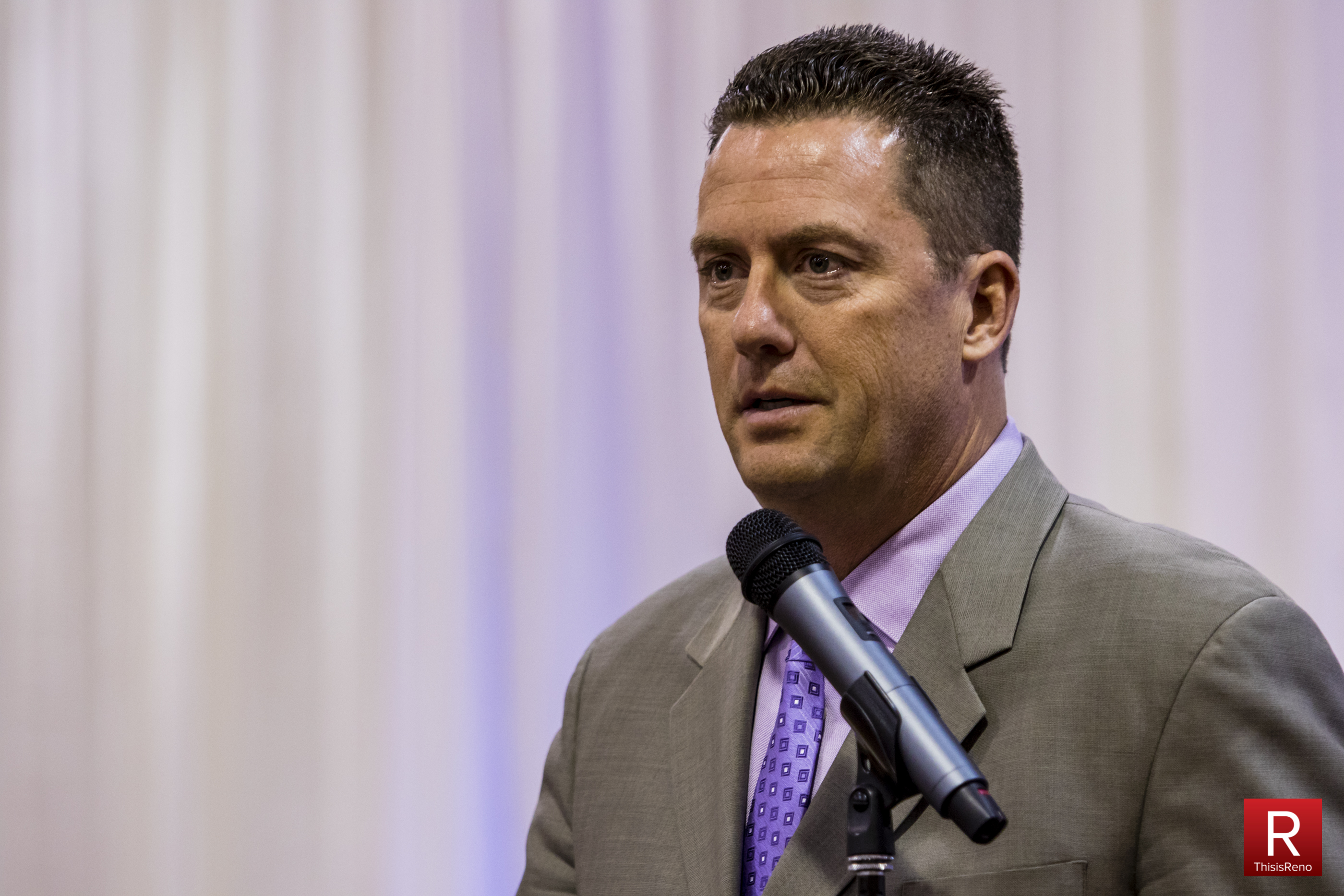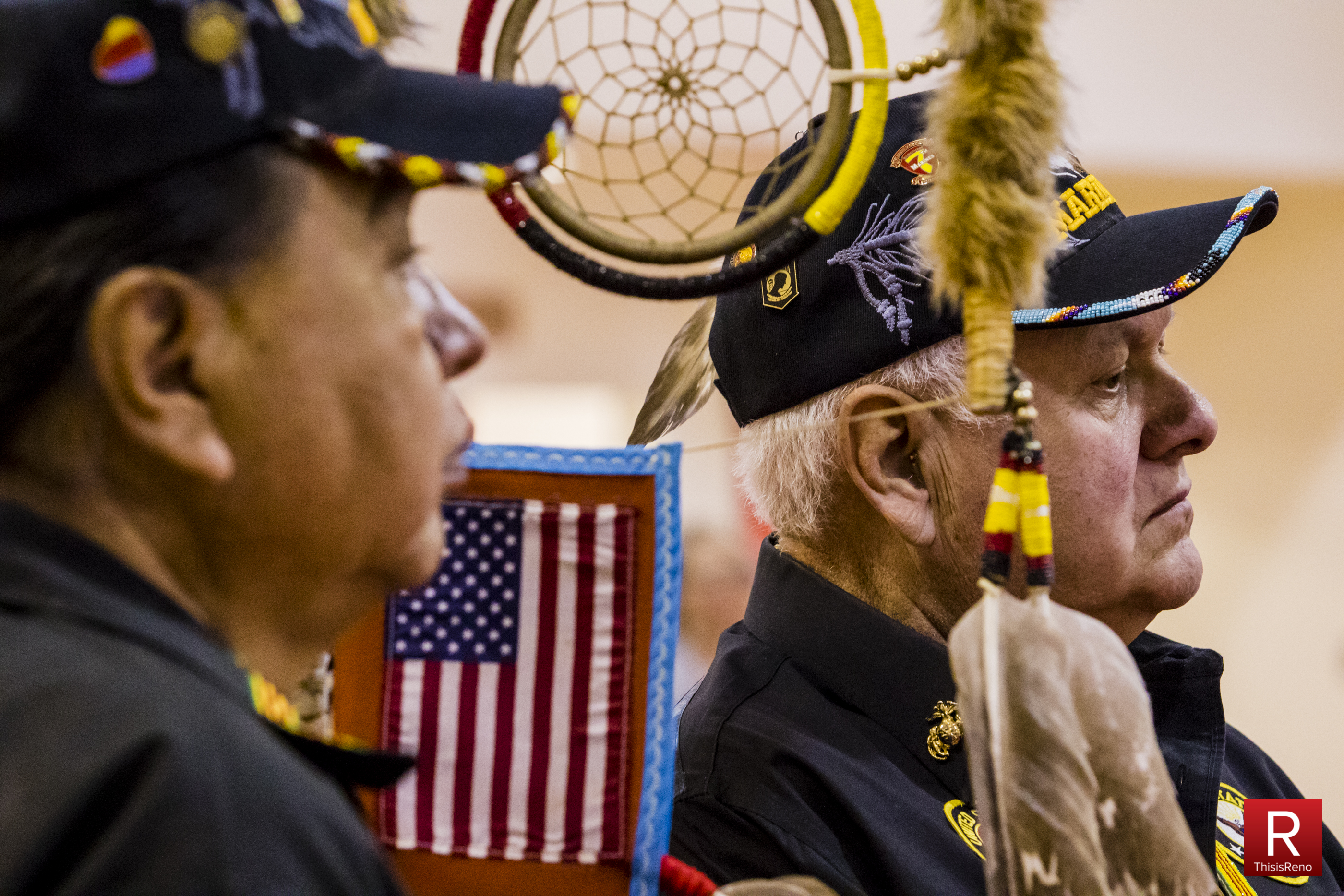View a photo gallery below.
Members of the Reno-Sparks Indian Colony, Duck Valley Shoshone-Paiute Tribe, Duckwater Shoshone Tribe, Fort McDermott Paiute-Shoshone Tribe, Pyramid Lake Paiute Tribe, and the Summit Lake Tribe gathered today in the Hungry Valley Gymnasium. While normally used as a basketball court, the room had been converted into a conference hall complete with stage, dining tables and photo backdrop. Caterers bustled in a side kitchen preparing lunch as event participants found seats and conversations. The event was celebrating the Nevada Native Nations Land Act, which repatriated over 70,000 acres across the six tribes.
The event began with an opening prayer from elder Margret Emm and the presentation of colors by the Pyramid Lake Veterans & Warriors organization. The gymnasium filled with the sound of drums thanks to the Battle Chief Singers as the color guard disembarked from the stage.
 The master of ceremonies, John Oceguera, took the stage and introduced members of the six tribes and other individuals critical to the Land Act’s success. He then welcomed Chairman Arlan Melendez to the stage. Melendez spoke about what it took to reach the day’s celebration. He emphasized how it took the efforts of all the tribes working together to pass the act. He specifically mentioned the Pyramid Lake Tribe’s willingness to take less land than they would have liked so that the Land Act would pass.
The master of ceremonies, John Oceguera, took the stage and introduced members of the six tribes and other individuals critical to the Land Act’s success. He then welcomed Chairman Arlan Melendez to the stage. Melendez spoke about what it took to reach the day’s celebration. He emphasized how it took the efforts of all the tribes working together to pass the act. He specifically mentioned the Pyramid Lake Tribe’s willingness to take less land than they would have liked so that the Land Act would pass.
He shifted to discussing the work done by Nevada politicians — specifically Congressmen Amodei, Senator Heller and now retired Senator Harry Reid. Amodei was the most discussed, especially in reference to a meeting inside of the Nugget Casino, held by the senator, that acted as a critical moment in the bill’s eventual success.
Sen. Heller and Sen. Reid played a major role by co-sponsoring the bill and creating bipartisan support. Unfortunately, neither of the senators were able to attended the event due to other engagements; their representatives, however, were on hand to accept gifts presented to them by the tribes. These included custom-made beaded baskets and sliver jewelry made by a member of the Reno -Sparks Indian tribe.
Lastly was a lobbyist by the name of John Waters whose knowledge of the political workings of Washington D.C. was described as invaluable. Alongside the other two gifts he received a custom made bolo tie that featured pinenut seeds, cattails and willows. Chairman Melendez described it as the highest honor they could bestow.
After the speeches ended, I had the opportunity to speak with Scott Nebesky about the Hungry Valley land that was part of the land act. We walked out of the gymnasium into a blustery wind with binoculars in hand. He explained that while the Bureau of Land Management (BLM) and other agencies try to define boundaries by squares of land, this technique would not work in Hungry Valley; instead, he said they used the valleys hydrographical layout to define the new boundaries. This matches Nevada’s geology and, with a separate acquisition of water rights, helps protect the community’s well water.
 I also had the opportunity to speak with Chairman Melendez about the future of the lands. The first thing, he explained, was the land acquisition. Now comes the time to decide what to do with it. While residential expansion is of course an option, a number of other economic possibilities have also been put forward. Note that these are all preliminary ideas. No decisions have been made. One possibility is creating a smaller version of the business complex in Storey County.
I also had the opportunity to speak with Chairman Melendez about the future of the lands. The first thing, he explained, was the land acquisition. Now comes the time to decide what to do with it. While residential expansion is of course an option, a number of other economic possibilities have also been put forward. Note that these are all preliminary ideas. No decisions have been made. One possibility is creating a smaller version of the business complex in Storey County.
Melendez explained that it would have to work within the community’s values and employ their residents. Other possibilities include desert agriculture inspired by Israeli water conservation or possibly greenhouse produce — “not marijuana” he quickly added with a chuckle.
He said that with the decreasing sales of tobacco products there is now an emphasis on diversification. He added that whatever the decision was, the land would not be sold and that, to them, land was not a commodity and will remain under the Reno-Sparks Indian Colony’s possession, even if they lease it.
While the event was a celebration, there was some talk of the challenges ahead. Hungry Valley serves as a recreation area for a lot of Reno’s off-road community and target shooters. Off-roaders who stay on trail and participate in cleaning the valley were spoken of highly — an example of why access should stay open.
Illegal dumping and target shooting, on the other hand, are not thought well of and pose a threat to the community.

































